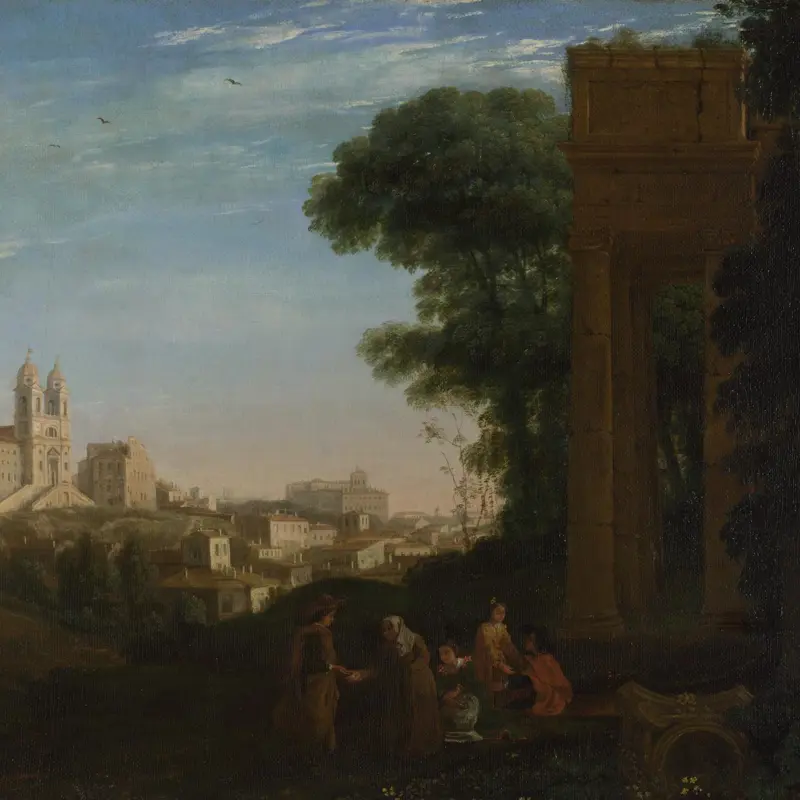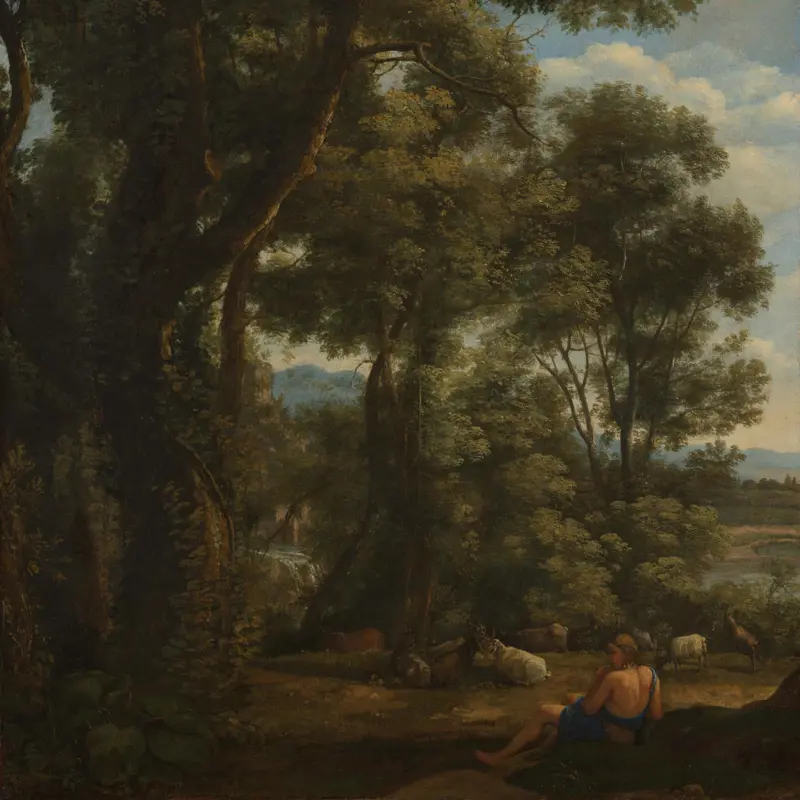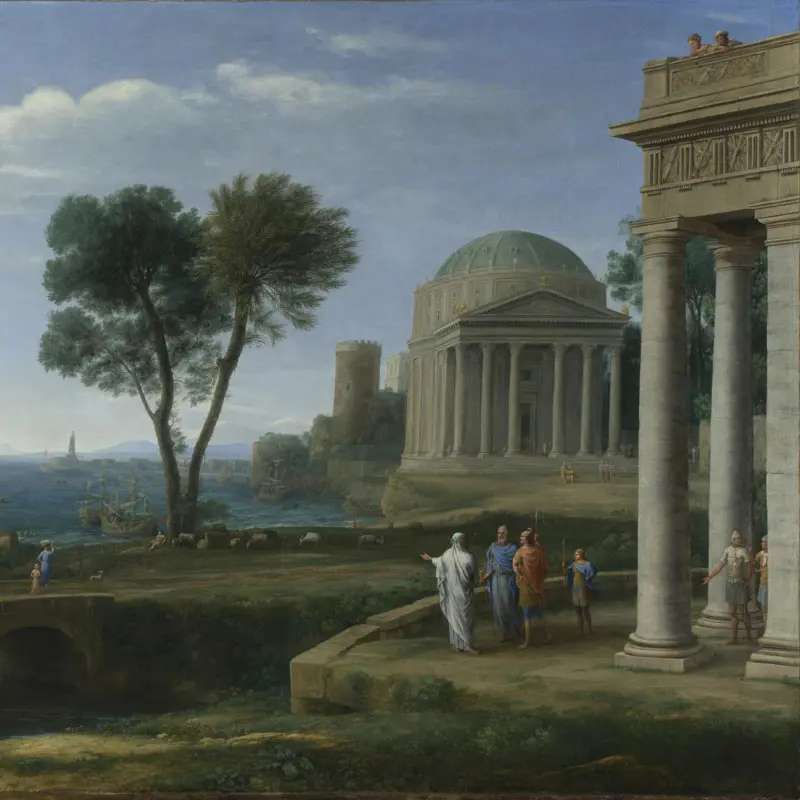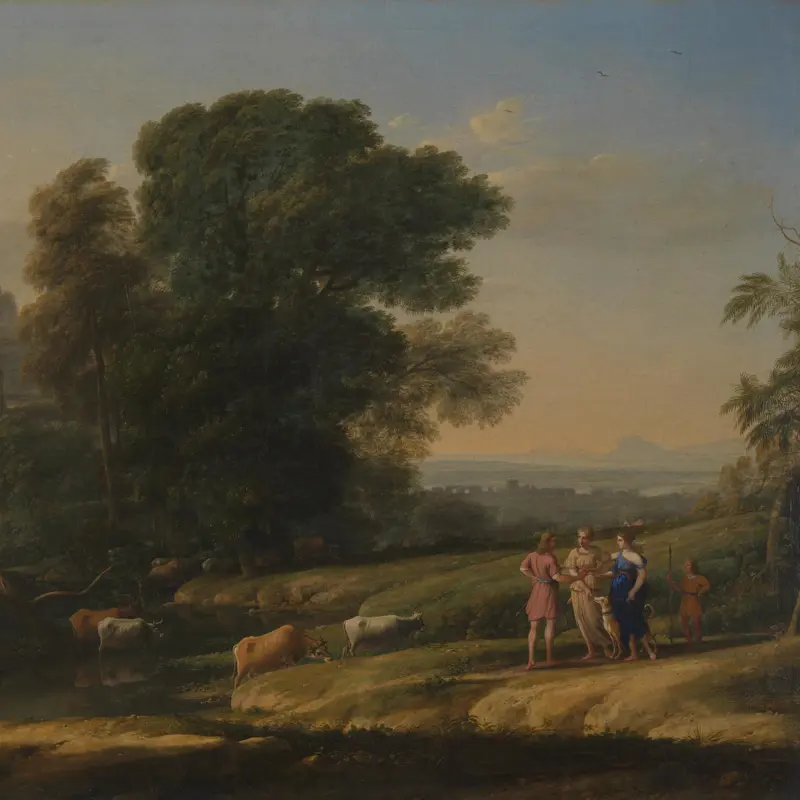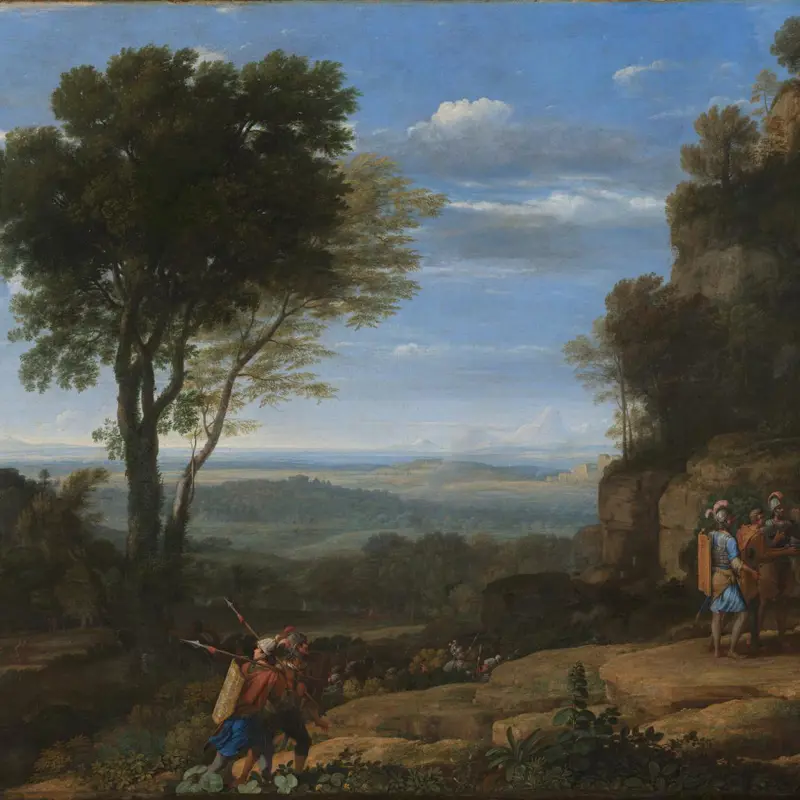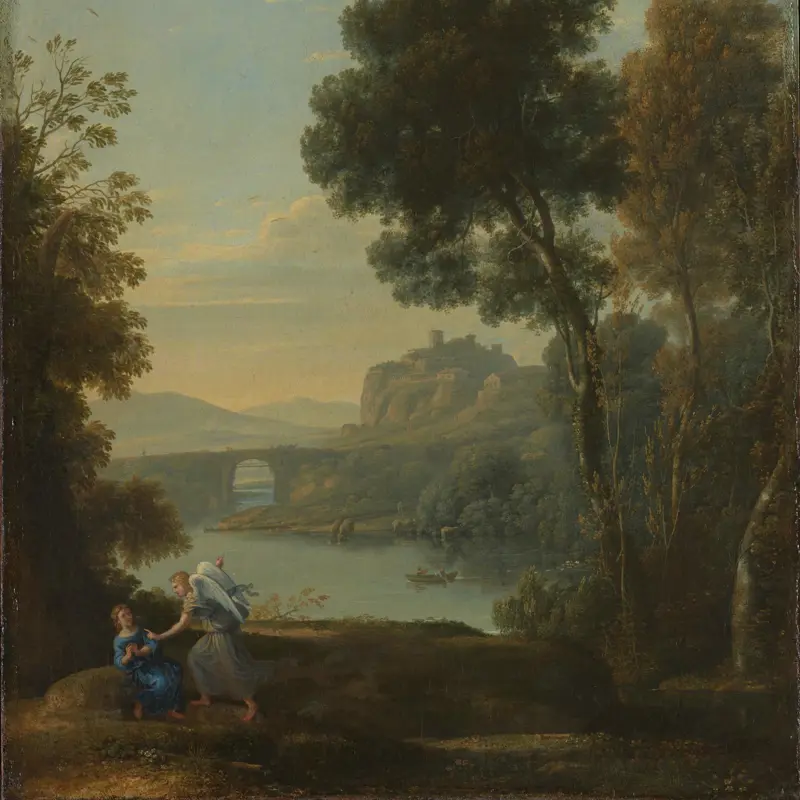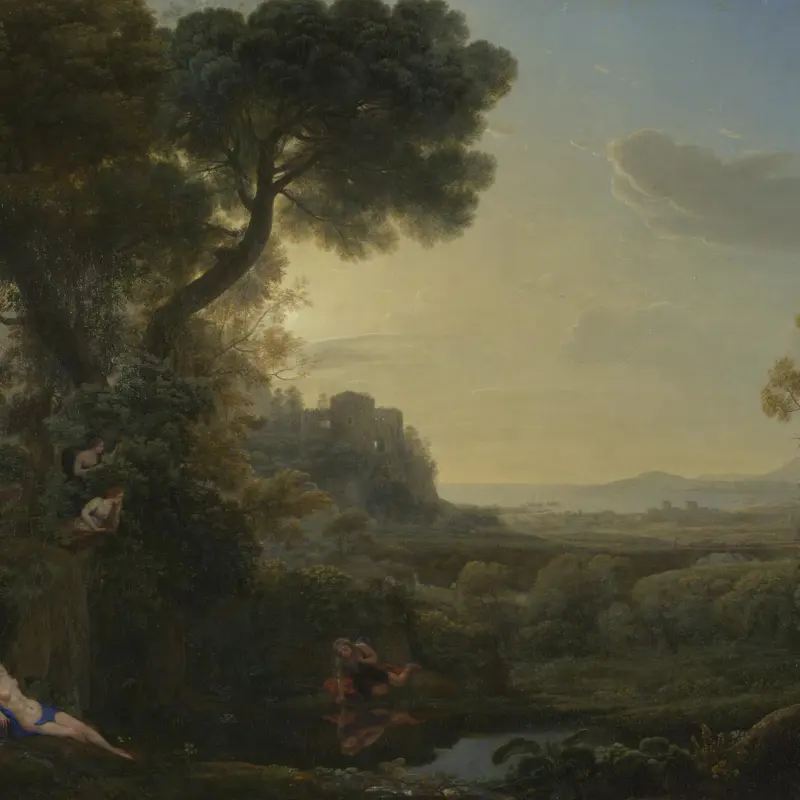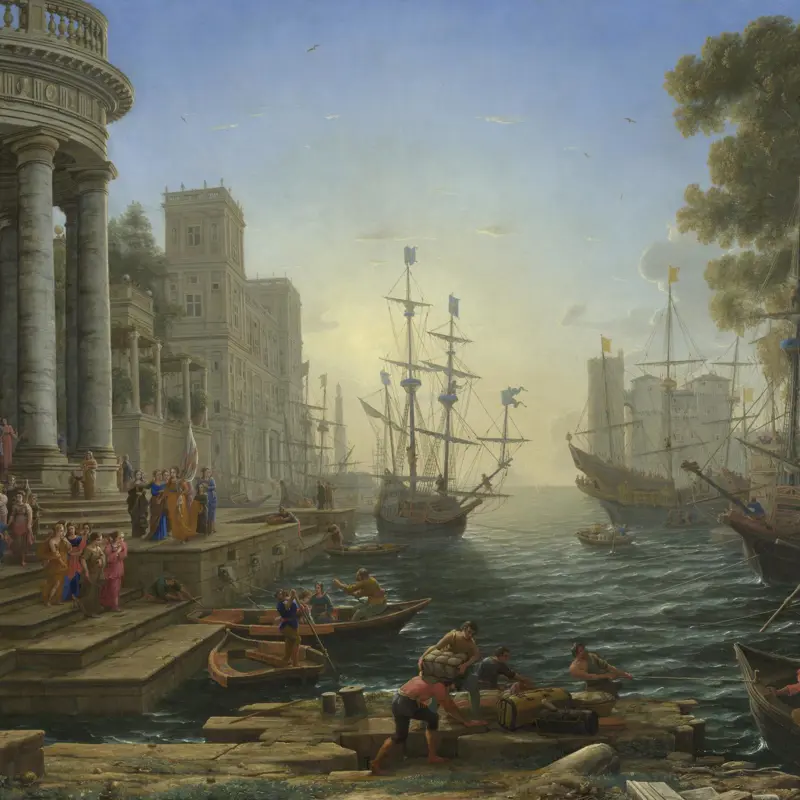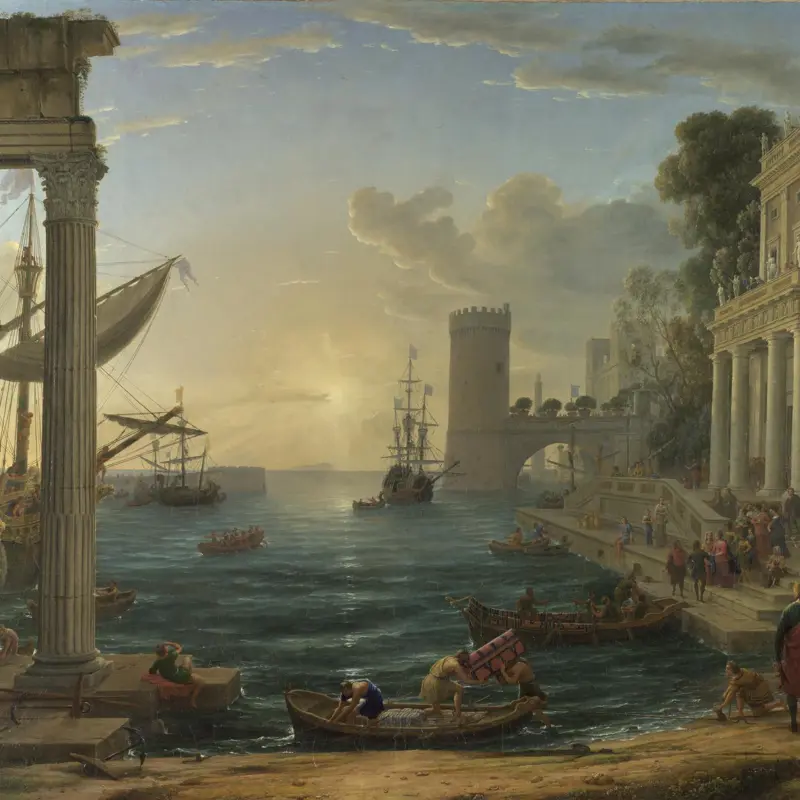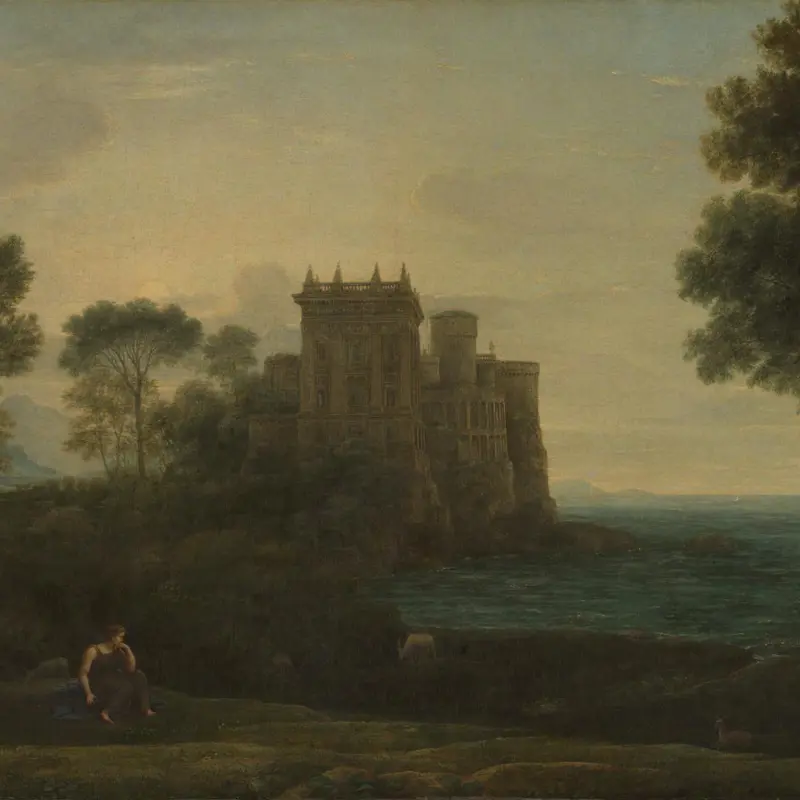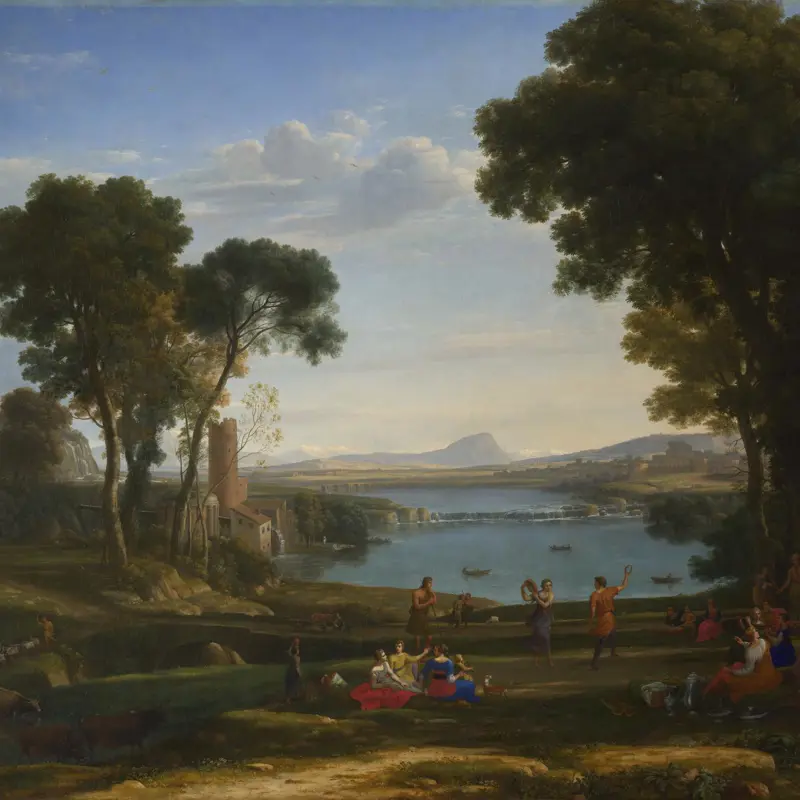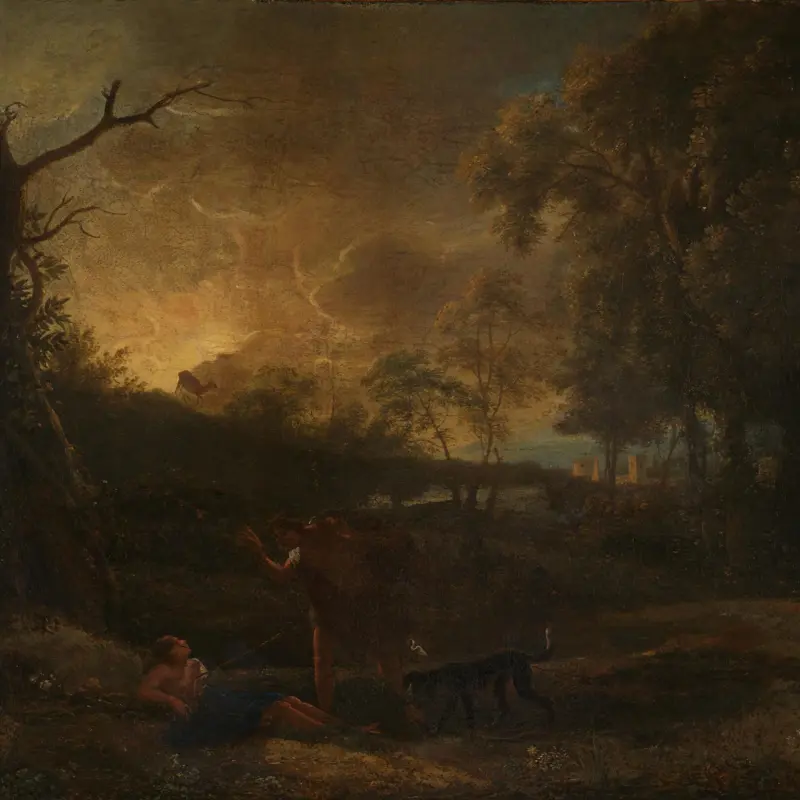Claude, 'A Seaport', 1644
About the work
Overview
This warm, tranquil port scene is bathed in sunlight: the clock on the building to the left records the time as five o'clock. A coat of arms with three golden fleurs-de-lis (emblem of the French king) above the clock and on the ship’s flags to the right suggests this painting was intended for a French patron. In the foreground, many of the figures glance towards this ship: the group of well-dressed men to the left are in conversation while others work hard or watch those gathered at the port.
This painted seaport is an imaginary scene, although the architecture is based on sixteenth-century buildings in Rome. The most distant building combines features taken from the Villa Farnesina and Palazzo Senatorio. The ornate entrance to the building in the foreground is inspired by the gateway to the Farnese gardens. Between these two buildings stands the Arch of Titus, an ancient Roman landmark.
Key facts
Details
- Full title
- A Seaport
- Artist
- Claude
- Artist dates
- 1604/5? - 1682
- Date made
- 1644
- Medium and support
- oil on canvas
- Dimensions
- 103 × 131 cm
- Inscription summary
- Signed; Dated
- Acquisition credit
- Bought, 1824
- Inventory number
- NG5
- Location
- Room 29
- Collection
- Main Collection
- Previous owners
- Frame
- 17th-century French Frame
Provenance
Additional information
Text extracted from the ‘Provenance’ section of the catalogue entry in Humphrey Wine, ‘National Gallery Catalogues: The Seventeenth Century French Paintings’, London 2001; for further information, see the full catalogue entry.
Exhibition history
-
2011Claude Lorrain: The Enchanted LandscapeThe Ashmolean Museum of Art and Archaeology6 October 2011 - 8 January 2012Städelsches Kunstinstitut und Städtische Galerie3 February 2012 - 6 May 2012
-
2020Masterpieces from the National Gallery, LondonThe National Museum of Western Art18 June 2020 - 18 October 2020The National Museum of Art3 November 2020 - 31 January 2021
-
2021Botticelli to Van Gogh: Masterpieces from the National Gallery, LondonNational Gallery of Australia5 March 2021 - 14 June 2021
Bibliography
-
1752A.-J. Dézallier d'Argenville, Voyage pittoresque de Paris, 2nd edn, Paris 1752
-
1793Paillet, Catalogue des tableaux précieux des écoles d'Italie, de Flandres, de Hollande et de France; figures & bustes… le tout provenant du cabinet de feu M. Choiseul-Praslin, Paris, 18 February 1793 - 25 February 1793
-
1823J. Young, A Catalogue of the Celebrated Collection of Pictures of the Late John Julius Angerstein, Esq: Containing a Finished Etching of Every Picture, and Accompanied with Historical and Biographical Notices, London 1823
-
1824W. Buchanan, Memoirs of Painting: With a Chronological History of the Importation of Pictures by the Great Masters into England Since the French Revolution, London 1824
-
1829
J. Smith, A Catalogue Raisonné of the Works of the Most Eminent Dutch, Flemish, and French Painters: In Which is Included a Short Biographical Notice of the Artists, with a Copious Description of Their Principal Pictures […], 9 vols, London 1829-1842
-
1862N. Lebrun, 'Cabinets des amateurs de Paris, en 1777', L'Almanach, 1862
-
1873L. Duvaux, Livre-journal de Lazare Duvaux, Paris 1873
-
1884Mme Pattison, Claude Lorrain, sa vie et ses oeuvres, Paris 1884
-
1903J. Ruskin, Modern Painters, eds E.T. Cook and A. Wedderburn, The Works of John Ruskin, 39 vols, London 1903
-
1946Martin Davies, National Gallery Catalogues: French School, London 1946
-
1957Martin Davies, National Gallery Catalogues: French School, 2nd edn (revised), London 1957
-
1961M. Röthlisberger, Claude Lorrain: The Paintings, London 1961
-
1972I.G. Kennedy, 'Claude and Architecture', Journal of the Warburg and Courtauld Institutes, XXXV, 1972, pp. 260-83
-
1975M. Röthlisberger, L'opera completa di Claude Lorrain, Milan 1975
-
1976D. Cordingly, 'Claude Lorrain and the Southern Seaport Tradition', Apollo, CIII, 1976, pp. 208-13
-
1977S. Corradini, 'La collezione del Cardinal Angelo Giori', Antologia di belle arti, I, 1977, pp. 83-8
-
1978A. Macintyre and K. Garlick (eds), The Diary of Joseph Farington, vol. 5, New Haven 1978-1984
-
1978M. Kitson, Claude Lorrain: Liber Veritatis, London 1978
-
1980J. Mills and R. White, 'Analyses of Paint Media', National Gallery Technical Bulletin, IV, 1980, pp. 65-7
-
1980M. Wyld, J. Mills and J. Plesters, 'Some Observations on Blanching (with Special Reference to the Paintings of Claude)', National Gallery Technical Bulletin, IV, 1980, pp. 49-63
-
1992H. Wine and O. Koester, Fransk Guldalder: Poussin and Claude and French Painting of the Seventeenth Century, (exh. cat. Statens Museum for Kunst, 29 February - 3 May 1992), Copenhagen 1992
-
1994H. Wine, Claude: The Poetic Landscape (exh. cat. The National Gallery, London, 26 January - 10 April 1994), London 1994
-
1996J. Edwards, Alexandre-Joseph Paillet: Expert et marchand de tableaux à la fin du XVIIIe siècle, Paris 1996
-
1997M.D. Rincón de Arellano, 'Turner visto por sus contemporáneos', Goya, 256, 1997, pp. 235-40
-
1999G. Bergmann, Claude Lorrain: Das Leuchten der Landschaft, München 1999
-
2001
C. Baker and T. Henry, The National Gallery: Complete Illustrated Catalogue, London 2001
-
2001H. Wine, National Gallery Catalogues: The Seventeenth Century French Paintings, London 2001
-
2002S. Richardson, Light: A National Gallery Touring Exhibition (exh. cat. The National Gallery, 26 January - 7 April 2002; Laing Art Gallery, 20 April - 7 July 2002; The National Gallery, London, 18 July - 6 October 2002), London 2002
-
2003P. Spencer-Longhurst, The Sun Rising through Vapour: Turner's Early Seascapes (exh. cat. The Barber Institute of Fine Arts, 24 October 2003 - 25 January 2004), Birmingham 2003
About this record
If you know more about this work or have spotted an error, please contact us. Please note that exhibition histories are listed from 2009 onwards. Bibliographies may not be complete; more comprehensive information is available in the National Gallery Library.

